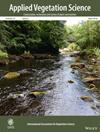Using multiple plant functional types to assess response to prescribed burn season in Mediterranean-climate vegetation
Abstract
Questions
Prescribed burning is a key tool for managing vegetation for conservation in fire-prone ecosystems around the world. Plants are adapted to particular fire regimes, made up of components including fire frequency and seasonality. However, burning outside historical regime parameters may impact species recovery and subsequent community assembly. We asked (i) do shrub species respond differently to spring and autumn fires, the primary times for prescribed burns in many temperate regions and (ii) does the use of novel functional groups, based on seed and seed bank traits, allow more robust predictions of response to shifting fire season?
Location
Mediterranean-climate southern Australia.
Methods
We surveyed 10 common shrub species to examine the impact of fire season on mortality, resprout vigour and seedling recruitment, using three functional groups: fire response (obligate seeder vs resprouter), seed storage (soil- vs canopy-stored), and seed dormancy class [physical (PY) vs morphophysiological (MPD)]. We also analysed individual species to assess species-specific responses.
Results
Obligate seeding and canopy seed-storing functional groups were negatively impacted by spring burns, with recruitment levels one third of that observed after autumn burns. For species with soil-stored seed banks, impacts of burn season were mediated by seed dormancy class, with PY species performing worse than their seasonally emerging MPD counterparts. Some individual species responded in stark contrast to others within their functional group.
Conclusion
Functional groups widely used to predict recovery, usually based on resprouting response and fire frequency, may not robustly predict responses to some fire factors, such as fire season. Our results highlight the importance that fire seasonality has on species response and potentially subsequent community assembly. We propose utilising multiple functional groups when assessing risk from shifting fire seasonality or when exploring impacts of multiple fire regime elements, and species-focused studies when managing species at high risk of extinction.


 求助内容:
求助内容: 应助结果提醒方式:
应助结果提醒方式:


